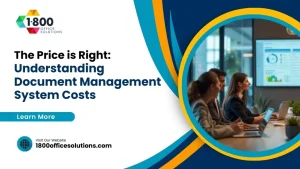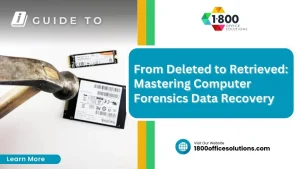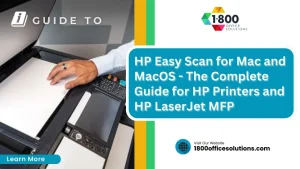Mastering the MSP Business Model: A Practical Guide

AI Overview: Comprehensive Guide to Building an MSP Business Model
This blog from 1-800 Office Solutions offers an in-depth roadmap for building and scaling a successful Managed Service Provider (MSP) business. Drawing from over 40 years of industry expertise in office technology and IT services, the guide breaks down every essential component required to create a sustainable, scalable, and profitable MSP operation.
Table Of Contents:
- Comprehensive Guide to Building an MSP Business Model
- Identify Key Components of an Effective MSP Business Model
- Develop a Comprehensive Business Strategy for MSPs
- Implement Efficient Operations and Service Delivery
- Focus on Building Strong Client Relationships
- Explore Growth Strategies for MSP Expansion
- Assess and Mitigate Risks in Your MSP Business
- Conclusion
Comprehensive Guide to Building an MSPBusiness Model
Are you facing difficulties in crafting an effective MSP business model? This guide outlines key components, details a structured business strategy, and demonstrates efficient operations to serve modern IT solutions. Business owners receive practical insights built on 40 years of expertise from 1-800 Office Solutions, known for leasing all-in-one printers, scanners, copiers, and fax machines while repairing office equipment. The content offers straightforward solutions to help resolve common operational challenges and drive long-term growth.
Identify Key Components of an Effective MSPBusiness Model

This section outlines essential factors for an MSP model: managed services advantages, understanding customer needs, setting service and pricing strategies, reviewing IT infrastructure, and establishing compliance and security standards. Also covered are skills required for quality delivery. Effective research, solid analytics, appropriate license verification, and the right tool strengthen the framework, much like a lawyer’s focus on precision in details.
Understand Managed Services and Their Benefits
Managed services supply companies with streamlined oversight of their IT infrastructure while ensuring smooth daily operations. The model delivers reliable information that supports strategic planning and refines pricing strategies to align with business goals.
This approach simplifies complex IT management by reducing system downtime and boosting service efficiency. Practical insights from managed services enable a company to adjust its pricing strategies based on infrastructure performance and clear information analysis.
Analyze Target Market and Customer Needs
The analysis of the target market helps business owners sharpen service offerings to meet specific customer needs and secure profit opportunities while setting a clear goal for service delivery. This approach prioritizes understanding the end user, ensuring that strategies are tailored to precise requirements and aligned with extensive industry experience.
Utilizing automation and internet-based tools provides reliable data that supports informed decision-making and streamlines service adjustments. This practical insight enables a focused strategy that meets customer expectations effectively, drives profit, and reinforces the overall business goal.
Determine Service Offerings and Pricing Strategies
A managed service provider must clearly define its service offerings by linking each option to client demands and cost implications, which reinforces its overall marketing strategy. A precise cost analysis forms the basis of pricing models that reflect both operational expenses and business objectives.
Service pricing should account for factors such as insurance coverage and maintenance fees to guarantee long-term stability. A well-structured table of contents that details service features and price points assists decision-makers while reinforcing the provider’s credibility in the market.
Explore Technology Infrastructure Requirements
The assessment of technology infrastructure requirements involves selecting reliable hardware and establishing secure data protection protocols. A robust backup system, paired with a trusted vendor, lays the foundation for stable operations, while strategic outsourcing can drive effective msp sales. This method allows companies to access expert support that streamlines daily processes and minimizes operational disruptions.
Efficient infrastructure planning also influences financial choices, with performance metrics playing a significant role in msp pricing decisions. Evaluating network capacity and system reliability offers actionable insights that enable businesses to adjust investments and maintain competitive service levels. This approach ensures that every component, from backup solutions to vendor partnerships, contributes to an optimized operational framework.
Establish Compliance and Security Protocols
Establishing compliance and security protocols remains a vital asset in creating a sound MSP framework. Industry professionals use a defined strategy and strict project management to convert audit feedback into actionable improvements.
Robust partnerships with regulatory bodies and technology vendors significantly contribute to maintaining high security standards. Regular reviews through project management and timely feedback ensure that each asset is shielded by evolving security measures.
Assess Skill Sets Needed for Service Delivery
Effective service delivery in an MSP setting requires a blend of technical expertise and business insight, where professionals proficient in cloud computing and antivirus software can address and mitigate system vulnerabilities. A strong foundation in entrepreneurship ensures that these specialists not only resolve technical issues but also drive service innovations that increase operational efficiency.
Success in service delivery also depends on clear communication and proactive outreach, with a well-trained sales team playing a crucial role. Combining practical experience with skills in social media marketing enables the organization to connect with potential clients and reinforce its reputation as a reliable managed service provider.
Develop a Comprehensive Business Strategy for MSPs

A strong MSP strategy starts with a clear mission and vision, setting real growth targets and outlining smart marketing and sales plans. Clear financial planning, focused brand positioning, and well-defined performance benchmarks, along with a business model canvas built on precise market analysis and data, drive effective customer service and reliable results.
Create a Mission Statement and Vision for Your MSP
A robust mission statement outlines the central purpose and strategic direction of an msp company. Clear articulation of a vision encourages a dedicated workforce to integrate modern technology and foster scalability while aiming for consistent income.
An effective vision emphasizes building strong processes that support both operational scalability and steady income growth. Industry expertise suggests that aligning organizational values with strategic technology investments and proactive workforce planning creates a reliable foundation for long-term success.
Set Realistic Goals and Objectives for Growth
Organizations set realistic growth goals by aligning a clear mission statement with data from the msp market and insights from msp marketing. They design objectives that address customer needs and adapt to changes in the current landscape.
Business leaders continuously review performance metrics to adjust targets for sustainable progress. They use regular analysis of the msp market and customer feedback to refine strategies, ensuring that every objective supports a solid mission statement in an ever-changing landscape.
Outline Marketing and Sales Strategies
A robust marketing approach in the MSP space relies on extensive experience and solid knowledge to showcase computer-based service benefits that meet business requirements. Targeted campaigns use clear messaging to convey technical advantages and support service choices with well-defined terms.
Sales planning focuses on creating incentive structures that drive engagement and facilitate swift decision-making. The strategy emphasizes straightforward contract terms to build trust and establish long-term relationships among business owners.
Financial Planning and Budgeting Essentials
The financial plan serves as the cornerstone for managing expense allocations and revenue streams while guiding the fee structure for various services. A focused budget sets the stage for investments in digital marketing and supports operational efficiency, which is vital for maintaining a robust remote work setup.
MSP leaders use precise budgeting to monitor cash flows and align spending with the overall business value they aim to deliver. Implementing a meticulous financial strategy assists in adjusting service fees in response to market trends and secures the necessary funds to enhance digital marketing and remote work capabilities.
Build a Strong Brand Identity for Your MSP
A refined brand identity distinguishes a provider in managed services through a clear demonstration of technical skill and commitment to quality. Emphasizing a robust network operations center and a streamlined sales approach supports effective lead generation while reinforcing trust among clients.
A consistent brand message bolsters credibility by highlighting specialized capabilities and practical achievements. The focus on sales performance, advanced technical skill, and a reliable network operations center creates a strong foundation for delivering managed services that meet client needs and foster continued growth.
Establish Key Performance Indicators for Success
MSP business leaders establish performance indicators that provide insight into operational success and drive strategy adjustments. They track real-time metrics to improve visibility and integrate artificial intelligence tools along with search engine optimization measures that address the target market and improve customer experience.
Regular monitoring of performance data enables companies to adjust strategies with precision and deliver services that meet client expectations. Industry experts rely on these key metrics to guide operational decisions, refine marketing tactics, and ensure that the target market receives a strong customer experience.
Implement Efficient Operations and Service Delivery

Effective operations drive service management and business efficiency. Key focus areas include designing workflow processes, adopting business management software, establishing customer support and service level agreements, training staff on best practices, monitoring performance metrics and client feedback, and adjusting for scalability. This proposition supports reliable it infrastructure, optimized server performance, timely patch management, and observed behavior trends.
Design Workflow Processes for Service Management
A structured workflow process enhances overall it service management by setting clear procedures that keep service tasks organized and timely. Clear steps allow for consistent follow-ups through cold calling and ensure that teams maintain an appropriate price structure throughout their daily operations.
Regular monitoring of performance data, including churn rate, offers valuable insights that drive process improvements and operational efficiency. A strategic investment in process automation and team training reinforces the workflow design and sustains reliable service delivery.
Invest in Business Management Tools and Software
Investing in business management tools and software provides a centralized platform that combines remote monitoring and management capabilities with an extensive knowledge base, offering a comprehensive understanding of daily operations. This robust approach supports managed service teams in tracking performance and addressing client needs promptly, ensuring a reseller maintains consistent service quality.
Modern software solutions streamline workflows by integrating real-time monitoring tools that offer actionable insights and clear performance metrics. This practical setup equips a managed service provider with a dynamic knowledge base, enabling efficient operations and empowering a reseller to respond quickly to evolving client requirements.
Create Customer Support and Service Level Agreements
A strong customer support framework, paired with well-defined service level agreements, serves as a cornerstone in an msp business by addressing the specific needs of the target audience. Industry specialists note that this framework enables an organization to build a solid business model that reinforces its reputation through consistent and transparent service delivery.
Clear contract terms and performance criteria in support agreements allow for prompt issue resolution and measurable service improvements. By adopting these practices, the organization secures a dependable support structure that solidifies its standing in the msp business and delivers practical value to its clients.
Train Staff on Best Practices and Procedures
A targeted program for staff training builds efficiency by aligning employee skills with the msp model framework. Regular sessions based on the executive summary assist employees in applying best practices that support a managed services business, strengthening brand awareness through reliable service delivery.
Consistent skill enhancement through hands-on exercises and periodic assessments boosts overall efficiency while addressing real-world challenges in the managed services business. Companies adopt clear training methods derived from the executive summary to refine the msp model and elevate brand awareness among their client base.
Monitor Performance Metrics and Client Feedback
An msp continuously monitors performance metrics with the help of reliable network monitoring tools to assess whether budget allocations yield the desired outcomes. Through regular analysis, msps identify areas for improvement and make quick adjustments that secure a competitive advantage in service delivery.
Client feedback also plays a vital role by providing direct insights that guide enhancements in service offerings and budget management. This practice allows an msp to respond effectively to client needs and maintain high operational standards that support ongoing success.
Optimize Operations for Scalability and Efficiency
Organizations seeking scalable growth optimize operations by structuring clear processes and aligning them with practical performance metrics. A limited liability company may boost revenue by refining its value proposition and establishing a reliable revenue stream that supports telecommunications needs.
Firms adjust daily practices through regular performance reviews and targeted process improvements to support dynamic service delivery. Active management of revenue and telecommunications infrastructure allows companies to maintain efficient operations while adapting to market demands.
Focus on Building Strong Client Relationships

Strong client relations guide managed service firms to meet client expectations through clear communication preferences and ongoing engagement. Regular check-ins and prompt attention to concerns help reduce risk and boost productivity. A reliable help desk, along with referral and loyalty programs, supports client retention, meets market demand, and reinforces targeted advertising efforts.
Understand Client Expectations and Communication Preferences
MSP experts gather client insights during the onboarding process to build a clear understanding of customer requirements and communication style. They utilize search engine data and direct feedback to shape service interactions that meet client expectations consistently.
The approach ensures that service delivery stays in tune with evolving customer needs by refining communication channels continuously. MSP professionals integrate onboarding experiences with search engine analytics to adjust messaging and support protocols that foster lasting client trust.
Develop Ongoing Client Engagement Strategies
MSP experts stress that regular communication forms the foundation of a solid relationship with clients. They implement proactive interaction methods and scheduled check-ins to address concerns in real time while ensuring service adjustments match evolving client needs.
A managed service provider sets clear engagement protocols that include routine surveys and direct feedback channels. This approach enables teams to measure performance accurately and fine-tune support strategies, building confidence and lasting trust among business owners.
Implement Regular Client Check-Ins and Reviews
Regular check-ins and timely reviews provide an effective mechanism for assessing client satisfaction in an MSP business model. These sessions enable service teams to clarify client requirements and promptly address any issues that arise during service delivery.
Scheduled client meetings support evaluating managed IT services, ensuring that feedback is integrated into everyday operations. This approach promotes consistent service quality and strengthens long-term client relationships.
Address Client Concerns and Feedback Promptly
Managed service providers review client concerns as they emerge and act swiftly to resolve issues in real time. This attentive approach fosters strong client relationships and instills confidence among business owners that their feedback is valued and acted upon.
Experienced MSP professionals use clear communication channels to gather feedback and adjust service protocols without delay. Their commitment to prompt issue resolution ensures that client needs are met efficiently while supporting continuous operational improvements.
Foster Long-Term Partnerships Through Trust
Reliable MSP providers build enduring partnerships through honest service delivery and transparent communication. Clients who rely on managed IT services and office equipment leasing appreciate a consistent approach that prioritizes trust and accountability.
Regular feedback and open dialogue promote a supportive environment where service standards are maintained and client concerns are resolved promptly. Industry experts observe that a dependable support framework secures ongoing commitment while reducing operational uncertainties for businesses.
Create Referral and Loyalty Programs for Clients
Companies design referral programs that award clients for recommending managed IT services and office equipment leasing. These programs offer tangible benefits such as fee discounts or service credits, which encourage word-of-mouth promotion and support steady business growth.
Providers implement loyalty initiatives that reward repeat customers with preferential pricing on maintenance and repair services. This strategy reinforces long-term relationships by addressing client needs directly and contributing to a dependable revenue stream.
Explore Growth Strategies for MSP Expansion

This section details key strategies for expanding an MSP business model. It covers diversifying service options, assessing merger and acquisition prospects, and forming partnerships with technology providers. It also outlines steps for increasing geographic reach, incorporating emerging technology trends, and evaluating market conditions regularly.
Identify Opportunities for Service Diversification
MSP providers can expand their service portfolio by integrating additional options such as office equipment leasing, repair services, and managed IT support. This strategy enables them to meet a broader range of business needs while capitalizing on proven industry expertise.
An in-depth analysis of client feedback and local market trends helps MSP organizations pinpoint new service areas that complement their existing offerings. By incorporating diversified services into their current framework, providers create a robust revenue stream and reinforce their reputation as reliable business partners.
Consider Mergers and Acquisitions for Growth
MSP companies may use mergers and acquisitions as a strategic method to broaden their operational scope and service capacity. This approach allows business owners to merge technical expertise and equipment leasing operations, resulting in a more balanced business model that addresses IT services and cybersecurity needs.
Firms often pursue these growth strategies to consolidate resources and improve operational management. Practical integration through mergers and acquisitions helps reduce costs and streamline service provision while maintaining a steady supply of high-quality office solutions.
Develop Partnerships With Technology Providers
MSP providers form robust alliances with technology providers to secure access to current hardware, software, and support services. These partnerships allow firms to integrate advanced IT solutions effectively, ensuring managed IT services remain reliable and responsive to client needs.
Collaborations with technology providers offer clear benefits by streamlining the implementation of new tools and facilitating rapid software updates. This approach strengthens the MSP business model and supports secure, efficient operations that meet the evolving demands of business owners.
Expand Geographical Reach of Your Services
MSP providers broaden their market boundaries by conducting detailed regional assessments and building strong local partnerships. They adjust service offerings for managed IT support, office equipment leasing, and repair services based on regional demand, resulting in improved operational reach and increased local business opportunities.
MSP companies use strategic planning to tailor solutions for new regions while maintaining high-quality IT services. They integrate regional market insights into service scheduling and cost planning to support steady growth and address the evolving needs of business owners across diverse areas.
Innovate With Emerging Technologies and Trends
MSP companies incorporate emerging technologies to update their service framework and bolster managed IT operations. They assess new trends in cloud computing, data security, and automation systems to refine office equipment leasing and repair services. This commitment to modern solutions positions MSPs to meet shifting market demands and deliver reliable support.
MSP firms test and adopt advanced software tools that improve system performance and boost efficiency. Pilot projects with emerging technologies enable these organizations to verify improvements and adjust service protocols based on real feedback. This measured approach supports steady growth and aligns services with the needs of business owners seeking robust IT solutions.
Continuously Assess Market Conditions and Adapt
Industry leaders regularly evaluate regional market trends, pricing adjustments, and technology updates to fine-tune their MSP models effectively. This ongoing analysis of performance data and customer insights helps them modify IT service offerings and office equipment leasing packages to meet current market demands.
MSP providers rely on established metrics and local market surveys to pinpoint growth opportunities and address emerging risks swiftly. By integrating fresh market insights with strategic investments in managed IT services, cybersecurity, and equipment support, these firms sustain operational strength while expanding their business reach.
Assess and Mitigate Risks in Your MSP Business

Identifying common pitfalls in MSP operations and establishing a robust risk management framework safeguards business continuity. This guide details disaster recovery planning, industry regulation compliance, staff training on risk awareness and mitigation, and regular risk reviews. The discussion offers practical insights and actionable methods to strengthen MSP stability and secure reliable service delivery.
Identify Common Risks Associated With MSP Operations
Managed service provider operations face risks such as unexpected service disruptions, cybersecurity threats, and challenges from outdated hardware that may affect IT services and office equipment leasing. Providers with extensive experience recognize that early risk identification and regular operational reviews help maintain service stability and protect business continuity.
Regular monitoring and targeted assessments allow providers to pinpoint vulnerabilities that could compromise system performance and compliance with industry standards. Proactive measures based on practical evaluations support the implementation of timely solutions while ensuring dependable support for client needs.
Develop a Risk Management Framework
Developing a risk management framework starts with identifying vulnerabilities in IT systems, office equipment operations, and service processes. MSP providers use structured assessments of data security protocols, maintenance routines, and regulatory requirements to establish clear safeguards that support uninterrupted service delivery. This approach enables firms to map potential risks and prepare responses that secure daily operations in equipment leasing and IT support.
MSP professionals review the framework regularly to pinpoint areas for improvement in risk detection and response. Systematic tests and defined performance indicators help adjust operational policies and react swiftly to emerging issues. Continuous training and diligent monitoring ensure that staff apply the framework effectively, supporting reliable managed IT services and equipment repair offerings.
Ensure Business Continuity and Disaster Recovery Plans
An effective business continuity plan offers a well-defined strategy for restoring managed IT services and office equipment operations during unexpected disruptions. Regular backups of critical data and routine disaster recovery drills help secure operational stability and reduce the impact of technical failures.
Organizations that implement structured disaster recovery plans experience quicker resolution of IT incidents and equipment malfunctions. Continuous evaluations and scheduled recovery exercises build confidence in the resilience of IT support, ensuring that service levels remain consistent and efficient.
Monitor Compliance With Industry Regulations
The MSP business monitors compliance with industry regulations by routinely auditing internal procedures and updating its operational policies. Automated tools and periodic manual checks provide actionable insights that help ensure both IT support and office equipment leasing practices meet current standards.
Regulatory guidelines are reviewed regularly, and the provider collaborates with compliance specialists to verify that established protocols remain effective. This proactive approach minimizes operational risks and reinforces client confidence in the service framework.
Educate Staff on Risk Awareness and Mitigation
A structured training program on risk awareness is pivotal for an MSP business model. Staff members participate in focused sessions that cover cybersecurity protocols and office equipment safety, ensuring they efficiently recognize and respond to potential IT issues.
Regular training updates provide employees with actionable insights and practical examples on managing system vulnerabilities. This proactive education cultivates a vigilant workforce that supports steady risk mitigation and reliable service delivery across IT support and equipment maintenance operations.
Perform Regular Assessments and Reviews of Risks
MSP providers perform frequent evaluations to scrutinize vulnerabilities across IT systems and office equipment leasing operations. Routine audits supply actionable insights that prompt timely updates to security protocols and maintain steady operational performance.
Industry professionals recommend scheduled risk reviews to monitor compliance issues and pinpoint performance gaps affecting service reliability. This practice enables MSP providers to implement prompt adjustments, ensuring robust managed IT services and secure equipment operations.
Conclusion
The guide outlines a robust framework of strategies and insights that enable MSP providers to construct a sound business model. It clarifies key processes such as market analysis, service definition, pricing strategies, and technical infrastructure planning. It also details practical methods for managing operational efficiency and mitigating risks while ensuring reliable service delivery. Business owners benefit from the actionable guidance that empowers them to sustain growth and confidently support quality office solutions.











